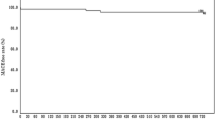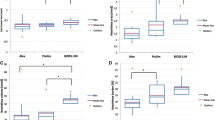Abstract
The restenosis rate of coronary stent has significantly decreased by implantation of the drug-eluting stent (DES). We often experienced the DES implantation for very small target vessels. The minimum size of DES in Japan and USA is 2.5 mm-diameter, but there were no reports of the expandability of DESs for the very small target vessels with reference diameter <2.2 mm. We clarify the expandable performance of 2.5 mm-DESs for very small target vessels with reference diameter <2.2 mm in vitro and vivo study. We studied 3 pieces in each kind of DES (Sirolimus-eluting stent; SES, Paclitaxel-eluting stent; PES, Zotarolimus-eluting stent; ZES and Everolimus-eluting stent; EES) in vitro and vivo study of the porcine coronary artery with reference diameter <2.2 mm. By using the delivery balloon, each stent was initially dilated with 3.5 atm. And the pressure of 0.5 atm. was applied until it reached the maximum pressure of 12 atm. The minimum pressure of the full expanded stent balloon was estimated as the minimum expandable pressure. The stent-inner diameter and area on each pressure were measured by IVUS. The average minimum expandable pressure (atm.) in vitro/vivo was 4.7/4.5 in SES, 7.2/6.8 in PES, 4.3/4.5 in ZES and 3.8/3.8 in EES. The inner diameter (mm) in vitro/vivo at minimum expandable pressure was 1.81 ± 0.07/1.84 ± 0.05 in SES, 2.31 ± 0.10/2.13 ± 0.13 in PES, 2.41 ± 0.13/1.98 ± 0.31 in ZES and 2.13 ± 0.11/1.88 ± 0.22 in EES. The stent inner-diameter (mm) of DESs at 8 atm. in vivo was 2.16/2.21/2.45/2.25 in SES/PES/ZES/EES. All kinds of DES could be delivered to very small target vessels with reference diameter <2.2 mm at the minimum expandable pressure in vivo study, but the stent which presented adequate stent inner-diameter at 8 atm. was only SES. We have to implant the 2.5 mm-DESs for very small target vessels according to the data based on this expandability of DESs to bail out threatening occlusion due to coronary dissection or elastic recoil.






Similar content being viewed by others
References
Fishman DL, Leon MB, Baim DS, Schatz RA, Savage MP, Penn I, et al. A randomized comparison of coronary-stent placement and balloon angioplasty in the treatment of coronary artery disease. N Engl J Med. 1994;331:496–501.
Serrys PW, Jaegere PD, Kiemeneij F, Macaya C, Ritsch W, Heyndrickx G, et al. A comparison of balloon expandable-stent implantation with balloon angioplasty in patients with coronary artery disease. N Engl J Med. 1994;331:489–95.
George CL, Baim DS, Brinker JA, Fichman DL, Goldberg S, Holubkov R, et al. One-year follow-up of the stent restenosis (STRESS I) study. Am J Cardiol. 1998;81:860–5.
Savage MP, Fischman DL, Rake R, Leon MB, Schatz RA, Penn I, et al. Efficacy of coronary stenting versus angioplasty on small coronary arteries. J Am Coll Cardiol. 1998;31:307–11.
Wahlau K, He Q, Ding ZP, Johan A. Safety and efficacy of angiography-guided stent placement in small native coronary artries of <3.0 mm in diameter. Clin Cardiol. 1997;20:711–6.
Horita Y, Kanaya H, Uno Y, Yamazaki T, Kaku B, Funada A. The study of intimal hyperplasia vs. reference diameter in Multi-Link Plus coronary stent: Late loss is not influenced by the reference diameter. Jpn J Interv Cardiol. 2003;18:457–62. (Japanese).
Sousa JE, Costa MA, Abizaid A, Feres F, Seixas AC, Tanajura LF, et al. Four-year angiographic and intravascular ultrasound follow-up of patients treated with Sirolimus-eluting stents. Circulation. 2005;111:2326–9.
Lemons PA, Hoye A, Goedhart D, Arampatzis AC, Saia F, Giessen WJ, et al. Clinical, angiographic, and procedural predictors of angiographic restenosis after Sirolimus-eluting stent implantation in complex patients. An evaluation from Rapamycin-eluting stent evaluated at Rotterdam Cardiology Hospital (RESEARCH) study. Circulation. 2004;109:1366–70.
Onuma Y, Kukreja N, Piazza N, Eindhoven J, Girasis C, Echenkeveld L, et al. The Everolimus-eluting stent in real world patients. 6-month follow-up of the X-SEARCH (Xience-V stent evaluated at Rotterdam Cardiac Hopsital) Registry. JAm Coll Cardiol. 2009;54:269–76.
Valgimigli M, Meighem CAG, Ong ATL, Aoki J, Granillo GR, McFadden EP, et al. Short- and long term clinical outcomes after drug-eluting stent implantation for the percutaneous treatment of left main coronary artery disease. Insight from the Rapamycin-eluting and Taxus stent evaluated at Rotterdam Cardiology Hospital Registries (RESEARCH and T-RESEARCH). Circulation. 2005;111:1383–9.
Park SJ, Kim YH, Lee BK, Lee SW, Lee CW, Hong MK, et al. Sirolumus-eluting stent implantation for unprotected left main coronary artery stenosis. J Am Coll Cardiol. 2005;45:351–6.
Kim YH, Park DW, Lee SW, Yun SC, Lee CW, Hong MK, et al. Long-term safety and effectiveness of unprotected left main coronary stenting with drug-eluting stents compared with bare-metal stents. Circulation. 2009;120:400–7.
Moses JW, Leon MB, Pompa JJ, Fitzgerald PJ, Holmes DR, O’shaughnessy C, Caputo R, et al. Sirolimus-eluting stents versus standard stents in patients with stenosis in a native coronary artery. N Engl J Med. 2003;349:1315–23.
Lemos PA, Serruys PW, Domberg RT, Saia F, Arampatzis CA, Hoye A, et al. Unrestricted utilization of Sirolimus-eluting stents compared with conventional bare metal stent implantation in the “Real World”. The rapamycin-eluting stent evaluated at Rotterdam Cardiology Hospital (RESEARCH) Registry. Circulation. 2004;109:190–5.
Violini R, Musto C, Felice F, Nazzaro MS, Cifarelli A, Petitti T, et al. Maintenance of long-term clinical benefit with Sirolimus-eluting stents in patients with ST-segment elevation myocardial infarction. J Am Coll Cardiol. 2010;55:810–4.
Weisz G, Leon MB, Holmes DR, Kereiakes DJ, Pompa JJ, Teirstein PS, et al. Five-year follow-up after Sirolimus-eluting stent implantation. J Am Coll Cardiol. 2009;53:1488–97.
Tongi M, Eber S, Widmer J, Billinger M, Wenaweser P, Cook S, et al. Impact of vessel size on outcome after implantation of Sirolimus-eluting and Paclitaxel-eluting stents. J Am Coll Cardiol. 2007;50:1123–31.
Mehilli J, Kastrati A, Pache J, Dirschinger J, Schoming A, for the intracoronary drug-eluting stenting to abrogate restenosis in small arteries (ISAR-SMART 3) study investigators. Randomized trial of paclitaxel- and sirolimus-eluting stents in small coronary vessels. Euro Heart J. 2006;27:260–6.
Kastrati A, Dibra A, Mehilli J, Mayer S, Pinieck S, Pache J, et al. Predictive factors of restenosis after coronary implantation of Sirolumus- or Paclitaxel-eluting stents. Circulation. 2006;113:2293–300.
Kastrati A, Mehilli J, Dirschinger J, Dotzer F, Schuhlen H, Neumann FJ, et al. Intracoronary stenting and angiographic results: Struts thickness effect on restenosis outcome (ISAR-STEREO) trial. Circulation. 2001;103:2816–21.
Pache J, Kastrati A, Mehilli J, Schuhlen H, Dotzer F, Hausleiter JO, et al. Intracoronary stenting and angiographic results: Struts thickness effect on restenosis outcome (ISAR-STEREO-2) trial. J Am Coll Cardiol. 2003;41:1283–8.
Nakagawa Y, Kimura T, Morimoto T, Nomura M, Saku K, Haruta S, et al. Incidence and risk factors of late target lesion revascularization after Sirolimus-eluting stent implantation (3-year follow-up of the j-Cypher Registry). Am J Cardiol. 2010;106:329–36.
Leon MB, Mauri L, Pompa J, Cutlip DE, Nikolsky E, O’Shaughnessy C, et al. A randomized comparison of the Endeavor Zotarolimus-eluting stent versus the Taxus Paclitaxel-eluting stent in de novo native coronary lesions. 12-month outcome from the ENDEAVOR IV trial. J Am Coll Cardiol. 2010;55:543–54.
Stone GW, Newman W, Mastali K, Wang JC, Caputo R, Doostzadeh J, et al. Everolimus-eluting versus paclitaxel-eluting stents in coronary artery disease. N Engl J Med. 2010;362:1663–74.
Serruys PW, Silber S, Garg S, Geuns RJ, Richardt G, Buszman PE, et al. Comparison of zotarolimus-eluting and everolimus-eluting coronary stents. N Engl J Med. 2010;363:136–46.
Feres F, Costa R, Abizaid A. Very late thrombosis after drug-eluting stent. Catheter Cardiovasc Interv. 2006;68:83–8.
Cook S, Ladich E, Nakazawa G, Eshtehardi P, Neidhart M, Vogel R, et al. Correlation of intravascular ultrasound findings with histopathological analysis of thrombus aspirates in patients with very late drug-eluting stent thrombosis. Circulation. 2009;120:391–9.
Cook S, Wenaweser P, Togni M, Billinger M, Morger C, Seiler C, et al. Incomplete stent apposition and very late stent thrombosis after drug-eluting stent implantation. Circulation. 2007;115:2426–34.
Kim YS, Koo BK, Seo JB, Park KW, Suh JW, Lee HY, et al. The incidence and predictors of postprocedual incomplete stent apposition after angiographically success drug-eluting stent implantation. Catheter Cardiovasc Interv. 2009;74:58–63.
Author information
Authors and Affiliations
Corresponding author
Rights and permissions
About this article
Cite this article
Horita, Y., Namura, M., Ikeda, M. et al. Which DES is the most appropriate for very small target vessels? Experimental study of stent expandable performance with SES, PES, ZES and EES. Cardiovasc Interv and Ther 26, 124–130 (2011). https://doi.org/10.1007/s12928-011-0053-4
Received:
Accepted:
Published:
Issue Date:
DOI: https://doi.org/10.1007/s12928-011-0053-4




